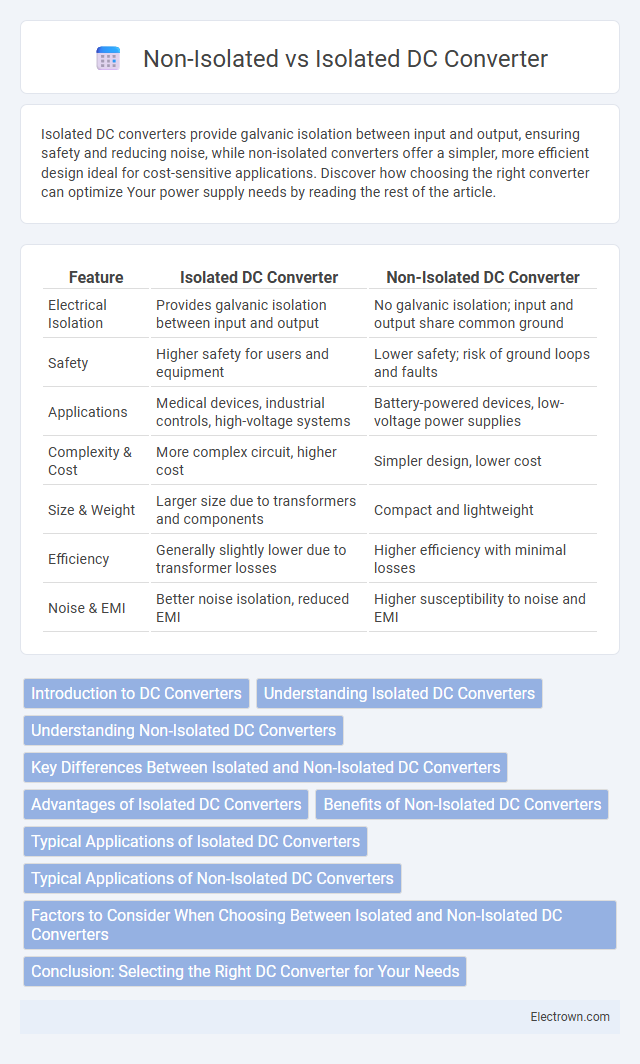Isolated DC converters provide galvanic isolation between input and output, ensuring safety and reducing noise, while non-isolated converters offer a simpler, more efficient design ideal for cost-sensitive applications. Discover how choosing the right converter can optimize Your power supply needs by reading the rest of the article.
Table of Comparison
| Feature | Isolated DC Converter | Non-Isolated DC Converter |
|---|---|---|
| Electrical Isolation | Provides galvanic isolation between input and output | No galvanic isolation; input and output share common ground |
| Safety | Higher safety for users and equipment | Lower safety; risk of ground loops and faults |
| Applications | Medical devices, industrial controls, high-voltage systems | Battery-powered devices, low-voltage power supplies |
| Complexity & Cost | More complex circuit, higher cost | Simpler design, lower cost |
| Size & Weight | Larger size due to transformers and components | Compact and lightweight |
| Efficiency | Generally slightly lower due to transformer losses | Higher efficiency with minimal losses |
| Noise & EMI | Better noise isolation, reduced EMI | Higher susceptibility to noise and EMI |
Introduction to DC Converters
DC converters are essential power electronics devices that transform direct current (DC) from one voltage level to another, ensuring efficient power management in various applications. Isolated DC converters incorporate galvanic isolation, typically using transformers, to separate input and output circuits, enhancing safety and noise immunity. Non-isolated DC converters lack this separation, offering simpler designs with higher efficiency and compact size, suitable for applications where isolation is not critical to Your system's performance.
Understanding Isolated DC Converters
Isolated DC converters utilize galvanic isolation through transformers to separate input and output circuits, enhancing safety and noise immunity in sensitive applications. These converters enable different ground potentials and reduce electromagnetic interference, making them ideal for medical, industrial, and telecommunications systems. Understanding isolated DC converters involves recognizing their role in providing voltage transformation, isolation barriers, and improved system reliability.
Understanding Non-Isolated DC Converters
Non-isolated DC converters share a common electrical ground between the input and output, enabling simpler designs and higher efficiency for applications requiring voltage step-up or step-down without electrical isolation. These converters typically use topologies such as buck, boost, or buck-boost, providing compact solutions for battery-powered systems, power management, and electronic devices. However, non-isolated converters lack galvanic isolation, which limits their use in scenarios demanding safety isolation or noise reduction.
Key Differences Between Isolated and Non-Isolated DC Converters
Isolated DC converters provide galvanic isolation between input and output using transformers, enhancing safety and noise reduction in sensitive applications. Non-isolated DC converters lack this isolation, offering simpler design, higher efficiency, and lower cost but limited protection against electrical faults. Your choice depends on the application's voltage requirements, safety standards, and EMI considerations.
Advantages of Isolated DC Converters
Isolated DC converters provide galvanic isolation, enhancing safety by preventing direct electrical connection between input and output, which is crucial in sensitive applications. They also reduce noise interference and improve signal integrity, ensuring stable and reliable power delivery for your devices. These advantages make isolated converters ideal for medical equipment, industrial controls, and renewable energy systems where protection and performance are paramount.
Benefits of Non-Isolated DC Converters
Non-isolated DC converters offer higher efficiency and reduced size due to the absence of isolation components, making them ideal for applications with tight space and power constraints. Their simpler design results in lower cost and easier integration into existing systems, enhancing overall reliability. These converters are well-suited for low-voltage, high-current scenarios where electrical isolation is not a critical requirement.
Typical Applications of Isolated DC Converters
Isolated DC converters are commonly used in medical devices, telecommunications, and industrial equipment where safety and noise reduction are critical. Their galvanic isolation protects sensitive circuits from high voltage transients and reduces electromagnetic interference. Your power system benefits from improved reliability and compliance with stringent safety standards when employing isolated DC converters.
Typical Applications of Non-Isolated DC Converters
Non-isolated DC converters are commonly used in applications requiring efficient voltage regulation within the same ground reference, such as point-of-load power supplies for microprocessors, battery-powered devices, and LED drivers. They are favored in systems where electrical isolation is not a critical safety or noise-immunity requirement, enabling compact design and higher efficiency. Examples include DC voltage step-down (buck) converters in telecommunications equipment, automotive electronics, and embedded systems.
Factors to Consider When Choosing Between Isolated and Non-Isolated DC Converters
Key factors to consider when choosing between isolated and non-isolated DC converters include electrical isolation requirements, system complexity, and safety standards. Isolated converters provide galvanic isolation, critical for preventing ground loops and protecting sensitive equipment, while non-isolated converters offer higher efficiency and simpler design in applications where isolation is not mandatory. Your decision should also weigh the voltage levels, noise immunity, and regulatory compliance to ensure optimal performance and safety.
Conclusion: Selecting the Right DC Converter for Your Needs
Choosing between isolated and non-isolated DC converters depends on the application's safety, noise isolation, and cost requirements. Isolated converters offer galvanic isolation, enhancing safety and reducing electromagnetic interference in sensitive environments, making them ideal for medical, industrial, and communication systems. Non-isolated converters provide higher efficiency and lower cost, suitable for applications where isolation is not critical, such as internal power regulation in consumer electronics.
Isolated vs Non-Isolated DC Converter Infographic

 electrown.com
electrown.com